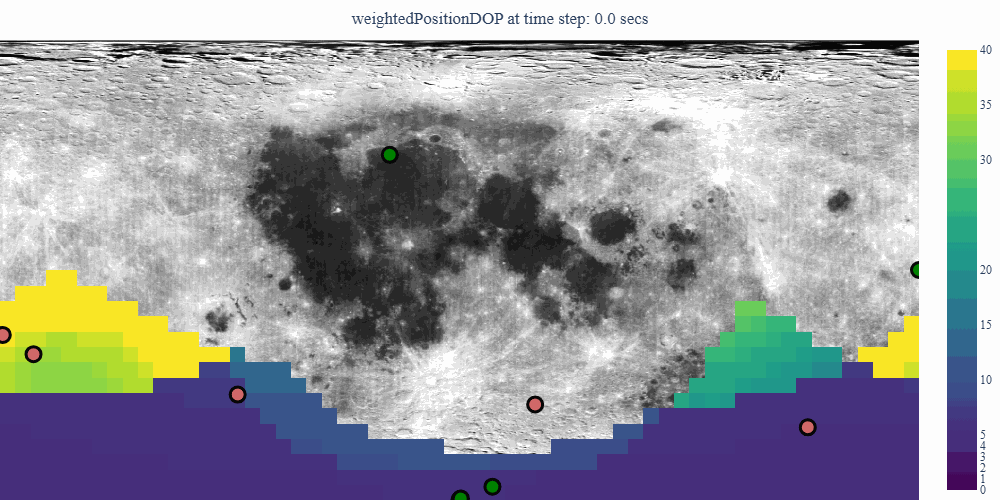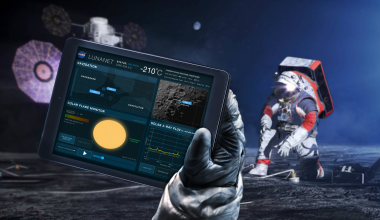The future space economy, by many measures, promises to include a robust degree of investment and activity in cislunar space by a multitude of space operators. How these efforts come together within the 550,000 km sphere of physical space beyond Earth’s surface may very well depend on how they integrate within a digital environment.
Interoperability between space capabilities, including a dozen core infrastructure layers, is critical for development in cislunar space to succeed and sustain over time. One way to foster interoperability over the long term is for players across the space enterprise to use common digital engineering environments as they design, integrate and continually evolve their capabilities.
Using the cislunar domain as an exemplar, The Aerospace Corporation is refining a digital toolbox that replicates the area of space between Earth and the Moon that could then be utilized by partners across government, commercial and academia to advance mission concepts and scientific understanding. More importantly, stakeholders will be encouraged to contribute data and insights, helping to shape a digital platform, the Aerospace Cislunar Modeling Environment (ACME), for the benefit of the nation’s space community.
The Value of Collaborating on Shared Challenges in a Shared Environment
The ability to navigate entire space system lifecycles through modeling and simulation in a digital environment has accelerated how space operators are reshaping the architectures and mission designs of the future. To that end, digital tools have become increasingly important to accelerating technological advancements for space exploration.
These include digital twins, which bridge the gap between the physical and virtual worlds by representing real-world objects and systems—whether they are naturally occurring, like the lunar surface or artificial, like spacecraft or communications networks—exactly as they are within a digital environment. Digital twins are dynamic: as the real-world object behaves, changes or responds to its environment, its digital counterpart simultaneously reflects those changes. This mirroring allows scientists and engineers to model, simulate and test in operational environments much faster, more efficiently and cost effectively.
“Digital twins provide a collaborative workspace for different organizations to interact and develop hybrid architectures that benefit both government and commercial space,” said Dennis Paul, senior project leader in Aerospace’s Space Enterprise Evolution Directorate. “Through real-time data sharing, version control and simulation capabilities, organizations can virtually test system interactions, identify conflicts and optimize designs.”
As an enterprise-level modelling environment, ACME will enable Aerospace to collaboratively work towards developing a digital twin of the lunar environment. The video above demonstrates the analysis for a PNT simulation on the lunar surface for a notional future mission involving a NASA commercial partner.
The Moon, as an immediate destination for human spaceflight, commercial innovation and economic development, provides a compelling test case for how digital twins might enable U.S. leadership in that domain. For example, engineers could use digital environments to model and simulate the physical challenges posed by the lunar surface and regolith, improving the development of critical solutions for power, mobility, communications and human-system interactions. Digital twins could also help the private sector navigate the Moon’s unique resource availability and environmental challenges to make better investment decisions.
Aerospace Cislunar Modeling Environment (ACME): A Pathfinder Prototype
The space enterprise is some steps removed from developing a true digital twin of the Moon that comprehensively represents the entire space community’s planned activities for cislunar space. However, efforts are well underway to leverage digital engineering environments for assets planned for deployment to cislunar space or already operating there.
Initially built to support NASA's Artemis campaign and U.S. Space Force testing around the Moon, Aerospace’s ACME tool serves as a prototype sandbox for the evolving cislunar ecosystem. Aerospace technicians developed ACME—an enterprise-level digital modeling tool—initially using custom tools with the potential for future integration with commercial-off-the-shelf tools.
Aerospace is using ACME to tackle multiple actions laid out in the National Cislunar Science & Technology Action Plan. First, the ACME team developed and simulated models for critical elements of cislunar infrastructure: communications, space situational awareness, and positioning, navigation and timing (PNT).
“ACME uses a body of knowledge from planned government and commercial modeling, simulation and mission profiles to model their interactions,” said Torrey Radcliffe, principal director for civil systems technology at Aerospace.

In one simulation of a notional future Artemis mission, ACME explored the capacity of the proposed LunaNet architecture to transport data between Earth and lunar landers, space-based and lunar surface missions and the lunar Gateway. Computer-generated graphics from the popular gaming platform Unreal Engine provided a compelling visual companion to modeled and simulated observational data.
These foundational simulations demonstrated ACME’s capability for modeling the unique physics environment of cislunar space and exemplifies how it can contribute as one of many innovative tools operating within a digital engineering ecosystem shared by the whole space industry.
A Strategic Foundation for Space Innovation
Aerospace is also playing a key role in bringing together key stakeholders across the nation’s space community to coordinate within a common digital engineering environment and marketplace. Notionally called the LUNAverse, it is a collaborative effort to develop shared engineering resources, governing principles and interoperability to enable innovations and a marketplace for the future of space at the enterprise level. Already, this effort has drawn interest from academic institutions – including Purdue University, MIT, Texas A&M and Georgia Tech – in collaborating to develop shared cislunar research infrastructure using a common engineering environment.
“This is not going to be an ‘Aerospace’ thing, just as the Internet evolved from the seminal ARPANET originator,” said Radcliffe. “The idea is for it to evolve into a publicly available cislunar digital engineering ecosystem that allows people to explore interactions of systems, link to existing digital twins and try new mission concepts. For everyone to tap into it and benefit, it’s going to have to get buy-in from everyone.”





